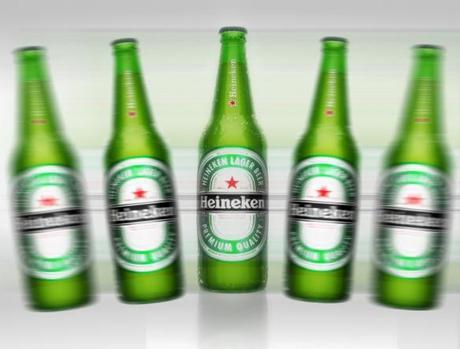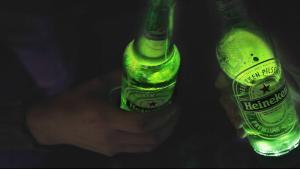 While beer enthusiasts the world over this week may have been decrying the threat of an AB InBev takeover bid of its main rival, SABMiller, a secondary detail to this story seems just as important.
While beer enthusiasts the world over this week may have been decrying the threat of an AB InBev takeover bid of its main rival, SABMiller, a secondary detail to this story seems just as important.
An AB InBev buy of SABMiller, the first and second-largest beer companies in the world, respectively, has been rumored for what feels like years, but it was SABMiller's attempt to takeover Heineken (#3 in the world) that kicked off this latest round of "will they or won't they" between AB InBev and SABMiller. As the Wall Street Journal reported, SABMiller wanted Heineken in an attempt to bolster their company's size and become an even major player globally.
So as people may wonder what will happen between the two biggest Big Beer players of them all, I'm left thinking ... why did Heineken spurn the advances of SABMiller?
In recent years, Heineken has fallen on hard times with an American audience, which, in its move toward craft beer, has left the green bottle of the Dutch brewing company behind. Sales of Heineken have continuously fallen in the U.S. over the past decade, with one estimation of a drop of one-third. In addition to problems with the "classic" Heineken brand, Heineken Premium Light is a failed experiment, ranking 17th in light beer dollar sales, and Amstel Light, owned by the company, has fallen off the map so drastically in the last few years it's not even considered worth tracking in sales analysis.
This is in spite of relative success elsewhere in the world, where the brewer still performs well in Europe and the UK. But in a beer world that is continuously expanding and innovating, America is still a " beacon market " by the company, even if Heineken may be considered a stodgy, European relic trying to be seen as hip and popular to an ever-changing consumer base.
And therein lies the company's main problem and what's holding them back from finding a solution.
Instead of reevaluating Heineken's brand position both in the U.S. and globally, executives are trying to transform their products like the nerdy girl who takes off her glasses, pulls down her hair from a bun and becomes prom queen. What we're seeing is feign attempts at innovation or simply imitation.
Take, for example, last year's attempt to boost Heineken Light sales by changing the brand's packaging and promoting the fact they planned to use Cascade hops in their beer:
"What we see and hear a lot about light beer now is consumers have become tired of the taste-the light brands are a little too watery for them and not a rewarding enough experience," said Olga Osminkina, senior brand director at Heineken USA. "Cascade hops are not a familiar addition to a light type of beer, so that's going to put Heineken Light in a different category."
However, the impact on taste is roughly equivalent of Miller Lite promoting that it's "triple-hopped brewed." For a company working to convert consumers from other beer brands that have specific, hoppy taste, there is no change. Instead, it seems clear the attempt is to convince consumers to try out Heineken Light because they might have heard about Cascade hops being important for craft beer, which is "cool" beer, so Heineken Light should be cool, too.
 Also consider last year's Heineken " Ignite " launch - a bottle that lights up according to certain movements or the sound of specific music. If you didn't think dubstep sounded odd before, now there's a visual element to it.
Also consider last year's Heineken " Ignite " launch - a bottle that lights up according to certain movements or the sound of specific music. If you didn't think dubstep sounded odd before, now there's a visual element to it.
Both these aspects - a gimmick with hops and tie-ins to the electronic dance music scene - scream for attention from young consumers. Which is exactly what Heineken is trying to do now.
In marketing to specifically target Millennial drinkers, Heineken has launched a few new products:
- Desperados, a "tequila flavored beer" clearly aimed at Corona drinkers.
- New Strongbow ciders to capitalize on the huge sales increase of that style of drink, but ones "that stand up to a beer lover's need for a bright refreshment and a wine lover's need for complexity and finish."
- Dos-A-Rita, the obvious answer to AB InBev's $462 million (in 2013) line of Bud Light "Ritas."
All of this seems like a scatter shot attempt to find success, which the company has only really seen with their Dos Equis brand that was the country's sixth-largest imported beer in 2012, the latest data I could find.
I get it, through. You launch Desperados because if you already have a successful "Mexican beer" alternative to Corona with Dos Equis, then you have greater chance of stealing market share. You research new ciders because that's what's hot. You offer up a "Rita" option because they make boatloads of money.
But what this really tells me is that as a company, Heineken doesn't have much going on for itself. All these decisions feel slightly desperate and after-the-fact, trying to maximize on the success of others. All the while, Heineken as a global, historic brand seems to be fading.
Like the Ritas Heineken is trying to clone to boost sales, product innovation now feels faked and forced.
Even more puzzling, going "all-in" on product development has given the company strong belief that it will succeed in the beer industry's new environment. So much so that leaders didn't want to sell any stake in Heineken to SABMiller. That's fine - as a business it's your responsibility to stay true to your principles and mission.
The problem is, I just don't understand what that is any more.
+Bryan Roth
"Don't drink to get drunk. Drink to enjoy life." - Jack Kerouac

